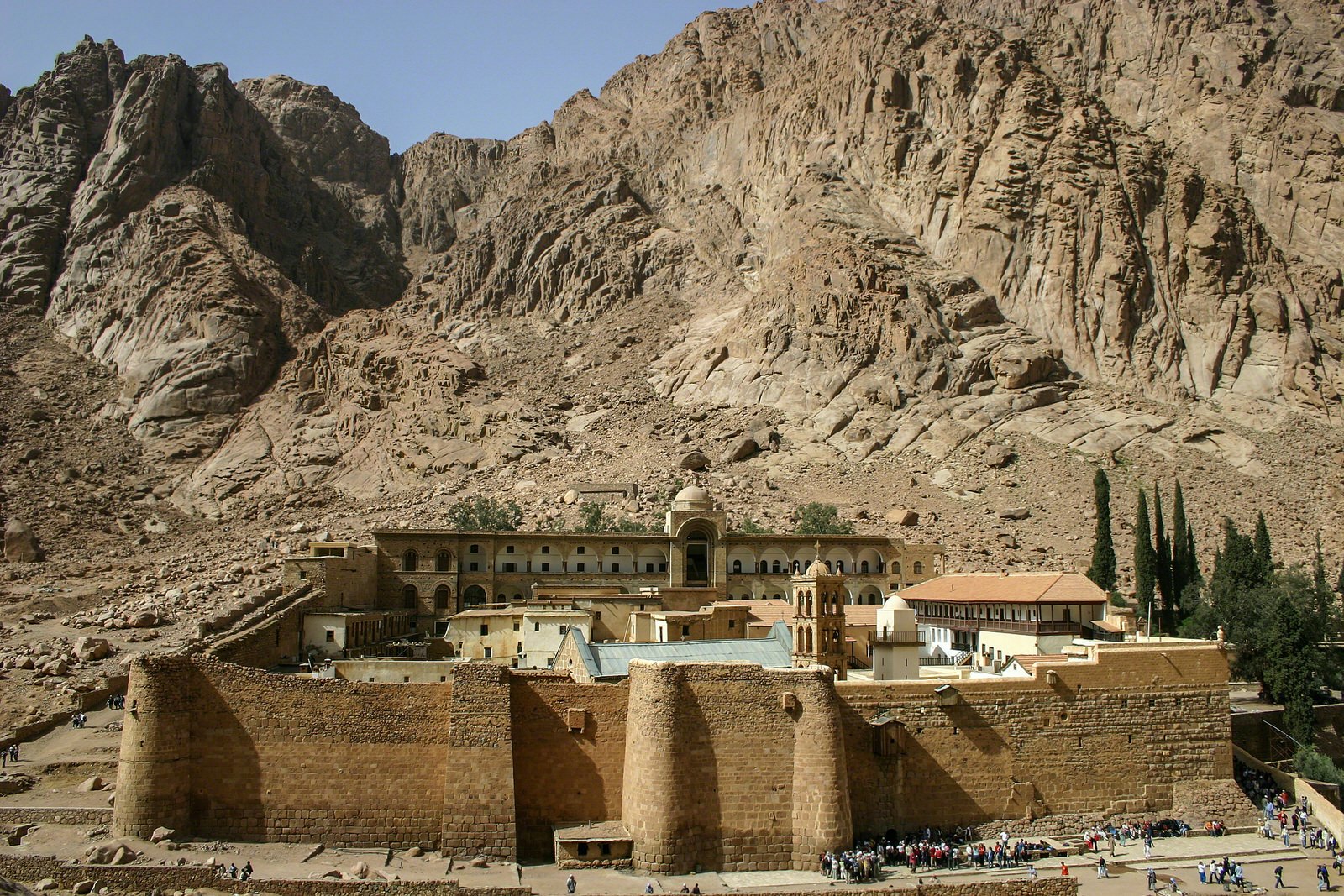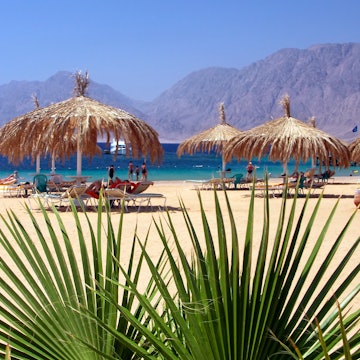

Stretching from the edge of the Red Sea to the highest point in Egypt, the Sinai Trail leads trekkers across scorched desert landscapes, past biblical monasteries and over windswept mountain passes, all while acquainting them with time-honoured Bedouin traditions.
Founded in 2015 by a collective of three Bedouin tribes, the nearly 250km trail is Egypt’s first long-distance walking path. It might be the country’s most high-profile entry into the world’s trekking scene, but the Sinai Peninsula is no stranger to walkers. Believers have made the overland journey to the storied summit of Mount Sinai for centuries, and the desert’s rocks are scored with drawings left by Crusader-era pilgrims.

It is both courteous and practical to hike the trail with a Bedouin guide and camels, which adds a compelling cultural element to the gorgeous scenery. Walkers can choose to hike a small section in a few days or tackle the entire distance – an adventure that can take up to two weeks.
But the Sinai is no stroll in the park; tricky ground surfaces and extreme weather conditions can make the trail tough going. The key to thriving in this overawing landscape is proper preparation, and bringing the right kit. Here’s our guide on what to pack to tackle the Sinai Trail.
On your feet
Most Bedouin guides wear flimsy plastic sandals, but abundant thorns and abrasive sand mean they’re a risky choice for all but desert-hardened feet. Lightweight boots or hiking shoes offer more protection on the uneven terrain. It’s important to bring a worn-in pair that won’t cause blisters, as high temperatures and sweaty feet make skin especially prone to irritation.
When picking shoes, skip anything with mesh panels – while ventilated shoes allow feet to breathe, they also let in annoying bits of sand and grit. Adding light wool socks to the mix gives an extra layer of protection, though stocking blister-prevention tape is still a must.

Looking the part
Since the majority of hikers choose to travel with camels, cutting weight isn’t as crucial as on a self-supported backpacking trip. But keeping gear to a minimum simplifies the daily routine and is kind to camels, so it’s worth choosing multi-purpose items of clothing that transition from hot days to cold nights.
Moisture-wicking base layers made from merino wool or synthetic material can be combined with several warmer garments and a windproof shell that can be added or removed when necessary. When choosing base layers, consider loose-fitting versions that cover the arms and legs – not only is it respectful to the norms of conservative Bedouin culture, it offers added protection from the sun.
While rain is rare in the Sinai Peninsula, a drenching downpour could be dangerously chilling, making a poncho or rain gear essential.
Sinai at night
Arid desert air cools quickly when the sun goes down. Given the dramatic change in elevation, pleasantly cool evenings at lower altitudes turn into freezing nights in the higher peaks.
As with clothing, versatility is key for soundless sleep on the Sinai. A warm (30 F/-1 C) sleeping bag can be supplemented with a silk or synthetic bag liner – the liner alone may be used as a lightweight sheet near the coast, then combined with the sleeping bag when temperatures plummet. When choosing a sleeping mat to pad and insulate the ground, foam is a better choice than inflatable versions, which are vulnerable to the abundant thorns and sharp rocks found in the desert.

Bedouin guides tend to sleep out in the open, wrapped in the thick blankets used to pad camel loads, and some hikers follow their example – the desert skies can be truly spectacular. A tent, though, offers welcome privacy for changing clothes and ensures that the Sinai’s crawling and slithering residents – snakes and scorpions – are kept at bay.
Feeling the burn
Even with a brimmed hat, sunglasses, and sunscreen, the Sinai sun can still be a challenge for some hikers. In addition to covering up, one option is to bring a trekking umbrella – either the specialised reflective variety that’s gaining popularity among ultralight backpackers, or a simple collapsible umbrella.
Packable tech
While the Sinai Peninsula is wonderfully photogenic, blowing sand and dirt shorten the life of sensitive electronics. Sealable, plastic liners packed inside camera cases help protect gear, as does a polarizing filter (essential for capturing memorable shots in the bright light of the desert).
Though much of the trail passes through remote patches with no mobile phone service, it’s possible to connect every few days – areas where signal is available are often marked with stone cairns. Small solar panels can be strapped to the outside of a daypack to keep mobile phones and batteries charged.

First aid and home comforts
While well-prepared guides may carry an emergency kit, packing first aid materials is crucial. A collection of tape, plasters, and antibiotic ointment takes care of blisters, and should be supplemented with the usual medications for travelling and hiking ailments, including antidiarrhoeal medicine, anti-inflammatories and rehydration salts.
As always, when travelling through the wilderness, emergency water treatment is essential, whether iodine tablets, chemical purification, or a UV purification system.
When travelling to the Sinai from abroad, it’s worth bringing any personal-care items from home – especially tampons, which can be both difficult and awkward to find while travelling in Egypt.
Hand sanitizer is also a good idea; as meals are often served and eaten communally using the hands it’s prudent to ensure there’s plenty available for your entire group. And since water on the trail is not used for washing, more hygiene-conscious trekkers might consider bringing along that all-encompassing travel staple: wet wipes.
Checklist
Soft-sided backpack – if travelling with a Bedouin guide, this will be carried by a camel
Day pack – sturdy enough to fit extra layers, water, snacks, and first aid
Hiking shoes
Camp shoes
Trekking poles
Water bottles – enough for a total of four litres
Sturdy, lightweight hiking trousers
Long-sleeve base layers, mid-layers, and warm jacket
Brimmed hat
Sunglasses
Poncho or rain gear
Lightweight wool hiking socks
Tent (optional)
Sleeping mat
Sleeping bag and sleeping bag liner
Headlamp and extra batteries
Water purification supplies
Emergency/first aid kit
Toiletries, wet wipes, toilet paper, lighter – toilet paper should be burned after use
Resealable plastic bag for rubbish
Sun cream
Personal snacks
Extra cash
Note: at the date of publication, the UK Foreign and Commonwealth Office advises against all but essential travel to South Sinai, including the area covered by the Sinai Trail.
Still not sure what to pack? Read out ultimate guide to packing like a pro before you go as well!
http://shop.lonelyplanet.com/egypt/egypt-travel-guide-12/















